



The Bronx Kill is a narrow strait in New York City delineating the southernmost extent of the Bronx. It separates the Bronx from Randalls Island. It connects the Harlem River to the East River. [1]




The Bronx Kill is a narrow strait in New York City delineating the southernmost extent of the Bronx. It separates the Bronx from Randalls Island. It connects the Harlem River to the East River. [1]
Originally, the Bronx Kill was a sizeable waterway, approximately 600 feet (180 m) in width. As of 1917, there were also plans by the War Department to dredge a 24-foot (7.3 m) deep channel, 480 feet (150 m) in width, to improve navigation and reduce tidal currents. For this reason, in the early 20th century the New York Connecting Railroad built a movable bridge across the Bronx Kill on the approach to the Hell Gate Bridge. [2] [3] Similarly, the truss bridge of the Triborough Bridge across the Bronx Kill was designed to be convertible to a lift bridge. [4] However, much of the Bronx Kill was later filled in to expand the parkland on Randalls Island.
The Bronx Kill offers a venue for kayakers and other human-powered boaters without the worry of larger vessel traffic. Canoe and kayak expeditions through the waterway begin on the Harlem River, near the Third Avenue Bridge. Crossings must be well timed for the tides, to ensure both the correct current direction and sufficient water height: at low water, parts of the Bronx Kill entirely bottom out, revealing muddy stretches, and assorted debris. There is also low air draft under the Randalls Island Connector. [5] Consequently, no commercial vessels navigate the kill, with local businesses mostly opting instead for road and rail transport, including the Oak Point Link along its north bank.
In 2001, the New York Power Authority offered to construct a pedestrian bridge linking the Bronx with Randalls Island—part of the agency's remuneration to the community for building two new power plants in the South Bronx. [6] That plan, however, fell by the wayside when local officials argued that an improved Triborough Bridge path would be sufficient. The state authority instead paid for energy efficiency measures in the borough as a whole, including a green roof on the Bronx County Courthouse.[ citation needed ]
At the time, the two sidewalks of the Triborough Bridge's Bronx Kill span were connected to one long ramp at the Randalls Island end. This provides difficult access. [7] Following years of negotiation for land with the operators of the Harlem River Yards on the north bank of the Kill, [8] the Randalls Island Connector bridge was constructed across the Kill. The $6 million bridge, located underneath Amtrak's Hell Gate Bridge, provides pedestrian and bicycle access between the island and the Port Morris neighborhood of the Bronx and to the South Bronx Greenway. [9] The connector opened in November 2015. [10]
A 2006 plan for a water park—the first in the nation for a large city—on the northwest corner of Randalls Island was controversial. Announced by the Giuliani administration as a $48 million, 15-acre (61,000 m2) project, the proposal expanded to encompass 26 acres (110,000 m2) at a projected cost of $168 million before being cancelled in 2007. [11]
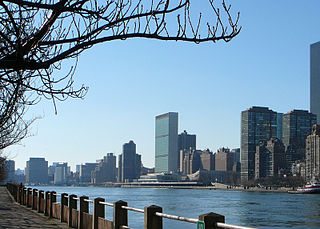
The East River is a saltwater tidal estuary in New York City. The waterway, which is actually not a river despite its name, connects Upper New York Bay on its south end to Long Island Sound on its north end. It separates Long Island, with the boroughs of Brooklyn and Queens, from Manhattan Island and from the Bronx.

Othmar Hermann Ammann was a Swiss-American civil engineer whose bridge designs include the George Washington Bridge, Verrazzano-Narrows Bridge, and Bayonne Bridge. He also directed the planning and construction of the Lincoln Tunnel.
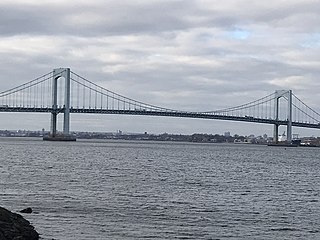
The Throgs Neck Bridge is a suspension bridge in New York City, carrying six lanes of Interstate 295 (I-295) over the East River where it meets the Long Island Sound. The bridge connects the Throggs Neck section of the Bronx with the Bay Terrace section of Queens.

The Robert F. Kennedy Bridge is a complex of bridges and elevated expressway viaducts in New York City. The bridges link the boroughs of Manhattan, Queens, and the Bronx. The viaducts cross Randalls and Wards Islands, previously two islands and now joined by landfill.

The Hell Gate Bridge, originally the New York Connecting Railroad Bridge or the East River Arch Bridge, is a 1,017-foot (310 m) steel through arch railroad bridge in New York City. Originally built for four tracks, the bridge now carries two tracks of Amtrak's Northeast Corridor and one freight track across the Hell Gate, a strait of the East River, between Astoria in Queens and Randalls and Wards Islands in Manhattan.
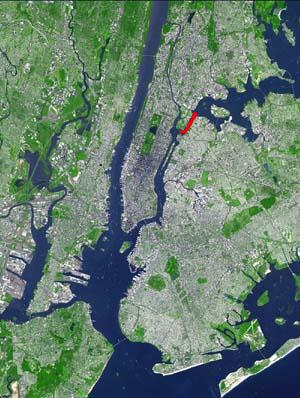
Hell Gate is a narrow tidal strait in the East River in New York City. It separates Astoria, Queens, from Randall's and Wards Islands in Manhattan.

The Bronx River, is a river that is approximately 24 miles (39 km) long, and flows through southeastern New York in the United States and drains an area of 38.4 square miles (99 km2). It is named after colonial settler Jonas Bronck. Besides the Hutchinson River, the Bronx River is the only fresh water river in New York City.

Spuyten Duyvil Creek is a short tidal estuary in New York City connecting the Hudson River to the Harlem River Ship Canal and then on to the Harlem River. The confluence of the three water bodies separate the island of Manhattan from the Bronx and the rest of the mainland. Once a distinct, turbulent waterway between the Hudson and Harlem rivers, the creek has been subsumed by the modern ship canal.

The Bronx–Whitestone Bridge is a suspension bridge in New York City, carrying six lanes of Interstate 678 over the East River. The bridge connects Throggs Neck and Ferry Point Park in the Bronx, on the East River's northern shore, with the Whitestone neighborhood of Queens on the southern shore.

Randalls Island and Wards Island are conjoined islands, collectively called Randalls and Wards Islands, in New York County, New York City, separated from Manhattan Island by the Harlem River, from Queens by the East River and Hell Gate, and from the Bronx by the Bronx Kill. The two islands were formerly separated, with Randalls Island to the north of Wards Island. The channel between them, Little Hell Gate, was infilled by the early 1960s. A third, smaller island, Sunken Meadow Island, was located east of Randalls Island and was connected to it in 1955.

Harlem River Drive is a 4.20-mile (6.76 km) long north–south parkway in the New York City borough of Manhattan. It runs along the west bank of the Harlem River from the Triborough Bridge in East Harlem to 10th Avenue in Inwood, where the parkway ends and the road continues northwest as Dyckman Street. South of the Triborough Bridge, the parkway continues toward lower Manhattan as FDR Drive. All of Harlem River Drive is designated New York State Route 907P (NY 907P), an unsigned reference route.

The Wards Island Bridge, also known as the 103rd Street Footbridge, is a bridge crossing the Harlem River between Manhattan Island and Wards Island in the Manhattan borough of New York City that does not allow vehicular traffic. The vertical lift bridge has a total of twelve spans consisting of steel towers and girders. It carries only pedestrian and bicycle traffic.
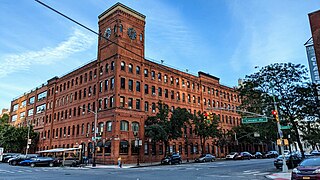
Port Morris is a mixed use, primarily industrial neighborhood geographically located in the southwest Bronx, New York City. The neighborhood is part of Bronx Community Board 1. Its boundaries are the Major Deegan Expressway and Bruckner Expressway to the north, East 149th Street to the east, the East River to the southeast, the Bronx Kill to the south, and the Harlem River to the west. Its ZIP Code is 10454 and 10451. The neighborhood is served by the NYPD's 40th Precinct.

The Manhattan Waterfront Greenway is a waterfront greenway for walking or cycling, 32 miles (51 km) long, around the island of Manhattan, in New York City. The largest portions are operated by the New York City Department of Parks and Recreation. It is separated from motor traffic, and many sections also separate pedestrians from cyclists. There are three principal parts — the East, Harlem and Hudson River Greenways.
The 125th Street Hudson River bridge was a proposed bridge across the Hudson River between 125th Street in Manhattan, New York City and Cliffside Park or Fort Lee in New Jersey. It was never built.

The East River Greenway is an approximately 9.44-mile-long (15.19 km) foreshoreway for walking or cycling on the east side of the island of Manhattan on the East River. It is part of the Manhattan Waterfront Greenway. The largest portions are operated by the New York City Department of Parks and Recreation. It is separated from motor traffic, and many sections also separate pedestrians from cyclists. The greenway is parallel to the Franklin D. Roosevelt East River Drive for a majority of its length.

Mill Pond Park is a public park in the New York City borough of the Bronx. It was built to compensate for the loss of parkland resulting from the construction of new Yankee Stadium between 2006 and 2009. The park's name was inspired by a dam near the site of a creek that emptied into the Harlem River.
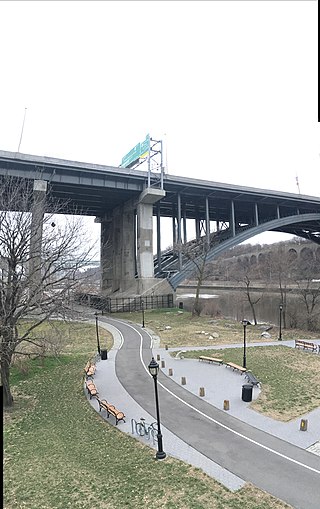
Bridge Park is a park in the Bronx, New York, created as part of a larger vision of creating connected waterfront parks along both sides of the Harlem River. The park's name references three large arch bridges linking Manhattan and the Bronx: Alexander Hamilton Bridge, Washington Bridge, and High Bridge.

The Hell Gate Line is the portion of Amtrak's high-speed Northeast Corridor between Harold Interlocking in Sunnyside, Queens, and Shell Interlocking in New Rochelle, New York, within the New York metropolitan area.

The South Bronx Greenway is a project to improve waterfront access, recreational facilities, and transportation systems, including pedestrian and bicycle paths, in the South Bronx in New York City.